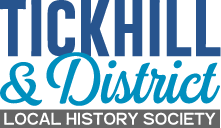

The White Horse Inn
During the 19th century, there were two licensed premises in Tickhill named the White Horse, which were trading at the same time for a period of about 50 to 60 years.
The earliest of these was on Northgate and a reference to this can be found in White’s 1837 Directory of the West Riding, which reads: ‘White Horse, Francis Gleadall, Northgt.’ The 1848 Tithe Map clearly shows an unnamed inn adjacent to the Three Crowns, whose occupant was Richard Wardingley; and this is confirmed in the 1851 census, where he is described as ‘Publican’. Further confirmation of the name appears ten years later, when the census refers to the inn as the ‘White Horse Inn’, with George Hartley named as ‘Victualler & farmer of 11 acres’. The last located references appear in the Register of Licences 1886-1891, when the licensee was Henry Mullins.
The second establishment known as the White Horse was situated on the north side of Sunderland Street about half way between Market Place and the Scarbrough Arms; unlike it’s namesake on Northgate, it was not an inn but a beerhouse. (See ‘Tickhill Beerhouses’ text on this website). The earliest located reference appears in the 1848 Tithe Award and Map, which lists Samuel White as the owner and occupier of a property described as a ‘public house, cottage and yard’; like many other licensees at the time, Samuel combined beerhouse keeping with his primary occupation, that of a ‘cordwainer’ (shoemaker).
In the 1870s, the licensee was George Gleadall and the White Horse began its long association with the Gleadall family. The property is listed as the White Horse on 1881 census, and from then until its closure in 1908, when an application for a renewal of licence was refused, Edward Gleadall is named as ‘beerhouse keeper’. Confirmation of its ‘beerhouse’ status appears in the Register of Licences 1886-1891.
Whilst most probably from the same family, a link has not been established between Francis, George and Edward Gleadall.
The sign of the white horse appeared on the standard of the Saxons, the arms of the House of Hanover and the arms of the Worshipful Company of Innholders, the latter being the most likely derivation of the above establishments.